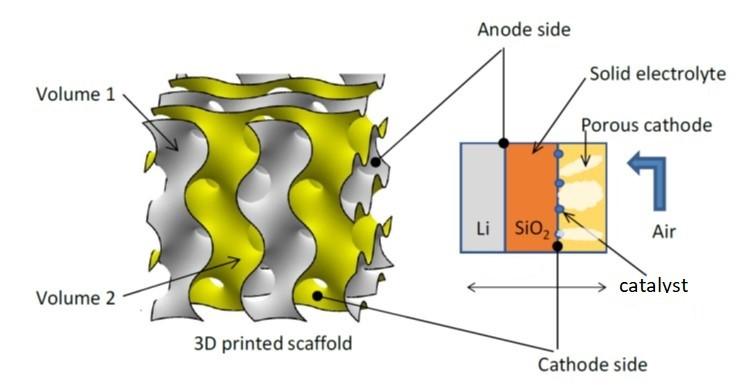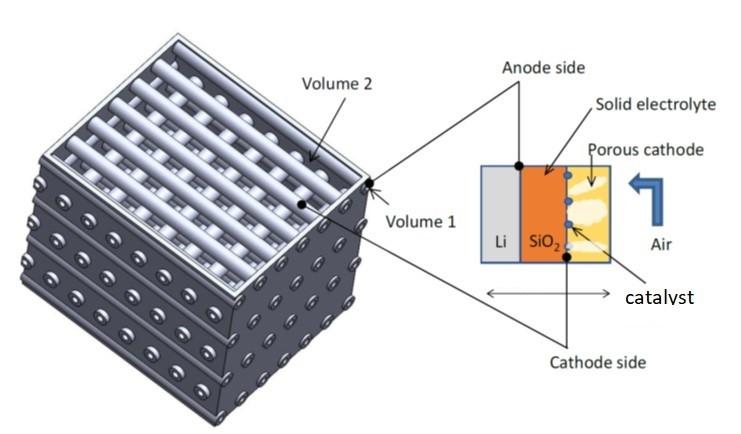Consumer electronics, which have become ubiquitous, require low cost, long lasting, and high energy density energy storage devices. As for grid and transportation (e.g. electric vehicles) applications, the ideal rechargeable battery must have (i) energy density comparable to gasoline and (ii) power density as well as charge-discharge lifecycle comparable to commercially available lithium-ion batteries. Since the energy density of lithium-ion batteries is fundamentally limited by their electrochemistry, other battery technologies need to be explored to achieve these objectives.
Lithium-air (Li-Air) batteries promise the highest energy density for rechargeable batteries. They are also lightweight and therefore have the potential to transform the automotive and customer electronics industries. Additionally, their low mass drives down the material cost of the batteries, making them well suited for grid storage needs. Unfortunately, in current Li-Air battery designs, electrolyte and anode “poisoning” reduces energy density and decreases cycle life. Innovation in this space will be required for lithium-air batteries to reach market potential.
To address these performance issues, solid state electrolytes have been incorporated into Li-Air design providing high cycle life but at the expense of lower power density. Another solution being pursued is to use liquid electrolytes with catalytic additives which lower interfacial resistance and thus increase power density. However, at present, this method has yielded low cycle life due to poor electrochemical stability of the liquid electrolytes. In addition, there is progressive electrolyte loss due to continuous exposure to air (or oxygen) at the cathode. These limitations result in the absence of Li-Air batteries in the marketplace.
LLNL researchers have developed a new 3D printable lithium-air battery that uses a novel thin solid state ceramic electrolyte. LLNL’s invention overcomes the combined challenges of low power density and low cycle life in previously designed lithium-air batteries by using solid state electrolytes to achieve stability and multiscale structuring of the electrolyte to achieve low interfacial resistance, respectively. The 3D structure of the foam-like electrolyte results in porosity at different scales, micro/nanoscale for the porous electrolyte and macroscale for the 3D geometry of the printed battery itself.
The printed battery features two distinct non-overlapping volumes and thin layers of electrochemically reactive material that can overcome the challenges of other lithium-air designs. One of the key enabling features of the battery is the patterning of both the cathode and anode onto a solid-state foam-like electrolyte structure to achieve extremely high surface area to volume ratios. This increases lifetime, efficiency, and power density. The novel 3D battery design that LLNL developed has the potential to achieve a 20x improvement in the energy density over the present commercial state of the art Li-ion batteries.
Embodiment of a solid-state lithium-air battery based on gyroid (left image) and log-pile (right image) foam:
Lithium-air batteries are viable alternatives to lithium-ion batteries with the added advantage that they have a theoretical energy density that is 20x more and therefore comparable to gasoline. LLNL researchers have developed a Li-Air battery that can offer:
- solutions that overcome challenges in other existing Li-Air battery designs
- the highest possible electrochemical use of lithium (via oxygen oxidation) while incorporating features to ensure it is safe (non-ignitable)
- high efficiency (>80% expected)
- the ability to operating over many (~1000+) cycles.
With energy densities on the scale of 5000 Wh/kg, this battery design promises to deliver nearly the full potential of Li-Air batteries – energy densities that no other existing battery type can match. Given the dominance of material cost in battery design, the 20X increase in energy density over lithium-ion batteries offers the potential to reach capital costs that are tens of orders of magnitude less than lithium-ion batteries.
- Energy storage for consumer electronics (e.g., laptops, cell phones, and other portable electronics) where form factor and weight are important considerations.
- Energy storage for electric vehicles
- Grid-level electricity storage
Current stage of technology development: TRL 2
U.S. Patent No. 11,444,347 Three-dimensional rechargeable battery with solid-state electrolyte issued 9/13/2022



